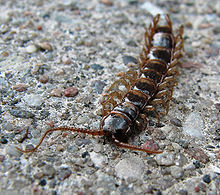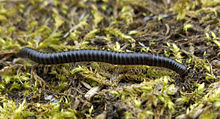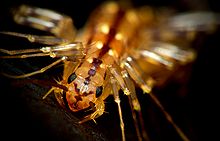- Myriapoda
-
Myriapoda
Temporal range: Late Silurian–Recent
Lithobius forficatus, a centipede Scientific classification Kingdom: Animalia Phylum: Arthropoda Subphylum: Myriapoda
Latreille, 1802Classes [1] - Chilopoda
- Diplopoda
- Pauropoda
- Symphyla
- Arthropleuridea (extinct)
Myriapoda is a subphylum of arthropods containing millipedes, centipedes, and others. The group contains 13,000 species, all of which are terrestrial.[2] Although their name suggests they have myriad (10,000) legs, myriapods range from having over 750 legs (Illacme plenipes)[3] to having fewer than ten legs.
The fossil record of myriapods reaches back into the late Silurian, although molecular evidence suggests a diversification in the Cambrian Period,[4] and Cambrian fossils exist which resemble myriapods.[2]
The scientific study of myriapods is myriapodology, and those who study myriapods are myriapodologists.[5]
Contents
Anatomy
Myriapods have a single pair of antennae and, in most cases, simple eyes. The mouthparts lie on the underside of the head, with an "epistome" and labrum forming the upper lip, and a pair of maxillae forming the lower lip. A pair of mandibles lie inside the mouth. Myriapods breathe through spiracles that connect to a tracheal system similar to that of insects. There is a long tubular heart that extends through much of the body, but usually few, if any, blood vessels.[6]
Malpighian tubules excrete nitrogenous waste into the digestive system, which typically consists of a simple tube. Although the ventral nerve cord has a ganglion in each segment, the brain is relatively poorly developed.[6]
During mating, male myriapods produce a packet of sperm, or spermatophore, which they must transfer to the female externally; this process is often complex and highly developed. The female lays eggs which hatch as much shortened versions of the adults, with only a few segments and as few as three pairs of legs. The young add additional segments and limbs as they repeatedly moult to reach the adult form.[6]
Ecology
Myriapods are most abundant in moist forests, where they fulfill an important role in breaking down decaying plant material,[2] although a few live in grasslands, semi-arid habitats or even deserts.[7] The majority are detritivorous, with the exception of centipedes, which are chiefly nocturnal predators. Pauropodans and symphylans are small, sometimes microscopic animals that resemble centipedes superficially and live in soils. Millipedes differ from the other groups in having their body segments fused into pairs, giving the appearance that each segment bears two pairs of legs, while the other three groups have a single pair of legs on each body segment.
Although not generally considered dangerous to humans, many myriapods produce noxious secretions (often containing benzoquinones) which can cause temporary blistering and discolouration of the skin.[8]
Classification
There has been much debate as to which arthropod group is most closely related to the Myriapoda.[9] Under the Mandibulata hypothesis, Myriapoda is the sister taxon to Pancrustacea, a group comprising the Crustacea and Hexapoda. Under the Atelocerata hypothesis, Hexapoda is the closest, whereas under the Paradoxopoda hypothesis, Chelicerata is the closest. This last hypothesis, although supported by few, if any, morphological characters, is supported by a number of molecular studies.[10]
There are four classes of extant myriapods, Chilopoda (centipedes), Diplopoda, Pauropoda and Symphyla, containing a total of around 12,000 species.[11] While each of these groups of myriapods is believed to be monophyletic, relationships among them are less certain.[12]
Centipedes
Scolopendra cingulata, a centipede Main article: centipede
Main article: centipedeCentipedes make up the order Chilopoda. They are fast, predatory and venomous, hunting mostly at night. There are around 3,300 species,[11] ranging from the diminutive Nannarup hoffmani (less than half an inch in length, c. 12 mm)[13] to the giant Scolopendra gigantea, which may exceed 30 centimetres (12 in).
Millipedes
 Tachypodoiulus niger, a millipede
Tachypodoiulus niger, a millipede Main article: millipede
Main article: millipedeMost millipedes are slower than centipedes, and feed on leaf litter and detritus. They are distinguished by the fusion of each pair of body segments into a single unit, giving the appearance of having two pairs of legs per segment. Around 8,000 species have been described, which may represent less than a tenth of the true global millipede diversity.[11] One species, Illacme plenipes has the greatest number of legs of any animal, with 750.[3] The name "millipede" is a compound word formed from the Latin roots milli ("thousand") and ped ("foot"), although millipedes typically have between 36 and 400 legs. Pill millipedes are much shorter, and are capable of rolling up into a ball, like pillbugs.
Symphyla
Main article: SymphylaAbout 200 species of symphylans are known worldwide.[11] They resemble centipedes but are smaller and translucent. Many spend their lives as soil infauna, but some live arboreally. Juveniles have six pairs of legs, but, over a lifetime of several years, add an additional pair at each moult so that the adult instar has twelve pairs of legs.[14]
Pauropoda
Main article: PauropodaPauropoda is another small group of small myriapods. They are typically 0.5–2.0 mm long and live in the soil on all continents except Antarctica.[15] Over 700 species have been described.[11] They are believed to be the sister group to millipedes, and have the dorsal tergites fused across pairs of segments, similar to the more complete fusion of segments seen in millipedes.[16]
Arthropleuridea
Main article: ArthropleurideaArthropleuridea were ancient myriapods that are now extinct. The most famous members are from the genus Arthropleura, which was a giant, probably herbivorous, animal that could be up to 3 metres (9.8 ft) long. Arthropleuridea may be a division of the millipedes.
References
- ^ "Myriapoda". Integrated Taxonomic Information System. http://www.itis.gov/servlet/SingleRpt/SingleRpt?search_topic=TSN&search_value=563885.
- ^ a b c Ben Waggoner (February 21, 1996). "Introduction to the Myriapoda". University of California, Berkeley. http://www.ucmp.berkeley.edu/arthropoda/uniramia/myriapoda.html.
- ^ a b Paul E. Marek & Jason E. Bond (June 8, 2006). "Biodiversity hotspots: rediscovery of the world's leggiest animal". Nature 441 (7094): 707. Bibcode 2006Natur.441..707M. doi:10.1038/441707a. PMID 16760967. http://www.nature.com/nature/journal/v441/n7094/abs/441707a.html.
- ^ Markus Friedrich & Diethard Tautz (2002). "Ribosomal DNA phylogeny of the major extant arthropod classes and the evolution of myriapods". Nature 376 (6536): 165–167. Bibcode 1995Natur.376..165F. doi:10.1038/376165a0. PMID 7603566.
- ^ Sue Hubbell (2000). Waiting for Aphrodite: Journeys Into the Time Before Bones. Houghton Mifflin Harcourt. p. 53. ISBN 9780618056842. http://books.google.co.uk/books?id=esw4_ksiTkEC&pg=PA53.
- ^ a b c Robert D. Barnes (1982). Invertebrate Zoology. Philadelphia, PA: Holt-Saunders International. pp. 810–827. ISBN 0-03-056747-5.
- ^ "Myriapod". Britannica Concise Encyclopedia. http://www.britannica.com/ebc/article-9054558.
- ^ "Strange and Unusual Millipedes". herper.com. http://www.herper.com/myriapods/strange.html. Retrieved July 2, 2007.
- ^ Gregory D. Edgecombe (2004). "Morphological data, extant Myriapoda, and the myriapod stem-group". Contributions to Zoology 73 (3): 207–252. http://dpc.uba.uva.nl/ctz/vol73/nr03/art02.
- ^ Alexandre Hassanin (2006). "Phylogeny of Arthropoda inferred from mitochondrial sequences: strategies for limiting the misleading effects of multiple changes in pattern and rates of substitution". Molecular Phylogenetics and Evolution 38 (1): 100–116. doi:10.1016/j.ympev.2005.09.012. PMID 16290034.
- ^ a b c d e A. D. Chapman (2005). Numbers of Living Species in Australia and the World. Department of the Environment and Heritage. p. 23. ISBN 0-642-56850-2. Archived from the original on 25 October 2007. http://web.archive.org/web/20071025220345/http://www.environment.gov.au/biodiversity/abrs/publications/other/species-numbers/pubs/number-living-species-report.pdf. Retrieved 01 January 2011.
- ^ Jerome C. Regier, Heather M. Wilson & Jeffrey W. Shultz (2005). "Phylogenetic analysis of Myriapoda using three nuclear protein-coding genes". Molecular Phylogenetics and Evolution 34 (1): 147–158. doi:10.1016/j.ympev.2004.09.005. PMID 15579388.
- ^ "Central Park survey finds new centipede". American Museum of Natural History. January 29, 2003. http://cbc.amnh.org/center/atthecbc/centi/centi.html.
- ^ "Garden Symphylans". Integrated Pest Management on Peppermint-IPMP3.0. Oregon State University. http://mint.ippc.orst.edu/symphid.htm. Retrieved July 2, 2007.
- ^ "Pauropods: Pauropoda". Insects and Spiders Scientific Reference. http://animals.jrank.org/pages/2563/Pauropods-Pauropoda.html. Retrieved July 2, 2007.
- ^ David Kendall (June 6, 2005). "Pauropods & Symphylids". Kendall Bioresearch. http://www.kendall-bioresearch.co.uk/myriapod.htm.
External links
 Data related to Myriapoda at Wikispecies
Data related to Myriapoda at Wikispecies Media related to Myriapoda at Wikimedia Commons
Media related to Myriapoda at Wikimedia Commons
Extant arthropod classes by subphylum Kingdom Animalia · Subkingdom Eumetazoa · (unranked) Bilateria · (unranked) Protostomia · Superphylum EcdysozoaChelicerata Arachnida (Araneae · Scorpiones · Opiliones · Acari · Pseudoscorpionida · Amblypygi · Thelyphonida · Solifugae · Palpigradi · Ricinulei · Schizomida) · Xiphosura · PycnogonidaMyriapoda Hexapoda Crustacea Branchiopoda · Remipedia · Cephalocarida · Maxillopoda (Cirripedia, Copepoda) · Ostracoda · Malacostraca (Decapoda, Amphipoda, Isopoda)Categories:- Arthropods
- Myriapods
Wikimedia Foundation. 2010.




